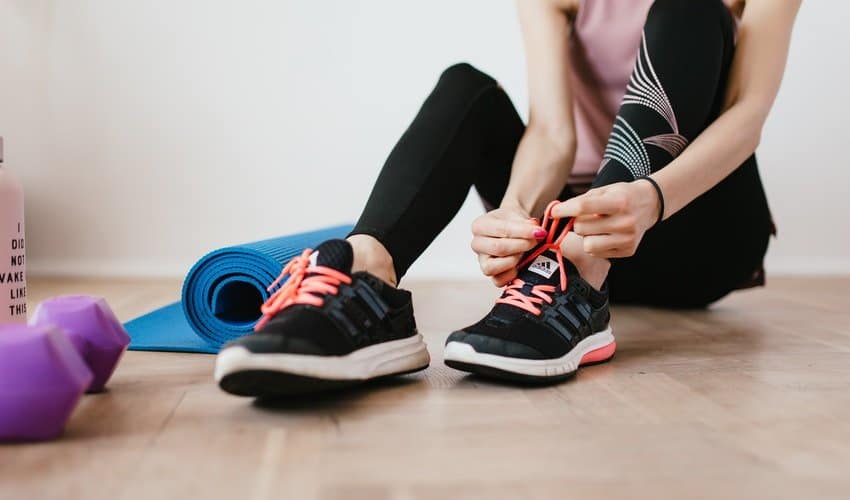Starting work out is an excellent initiative you can ever take for yourself.
It not only enhance your physical appearance but also improve your overall health and well-being.
Starting with the right workout plan is critical to build a solid base for your fitness journey and make progress faster. Otherwise, you might lose your motivation or end up with some injuries.
So in this article, I’m going to take you through a step-by-step beginner workout plan, guiding you exactly what you have to do for the first three months to master the critical exercises and build a solid foundation for your fitness journey.
I also attached the PDF of this 12-week beginner workout plan below! So, don’t forget to grab that.
Things to Know for Weight Training
Here’re the things you want/should know for weight lifting.
Be Consistent
Whether you want to achieve any goal in life or improve your health, the first and most important exam you need to pass out is consistency.
Here in fitness, you have to have consistent with your workout and diet. Because only diet or workout alone can’t give you the results.
When you’re starting to follow a workout or nutritional plan, you have to commit yourself to work on that plan at least for few weeks consistently to see some notable results.
After several years of training, I realize that when I haven’t the mood to work out but still start working out, most of the time, I end it by completing my entire session.
So, it’s crutial to keep rolling and don’t compromise to hit the gym, whether it is 5 minutes mini session or 60 minutes robust session.
Know What The Words Mean
Let’s learn what the words mean, which are frequently used in the gym.
Dumbbell: A dumbbell (DB) is a short bar with an adjustable or non-adjustable weight at each end. It’s used typically in pairs for exercise or muscle-building.
Barbell: A barbell (BB) is a long bar with adjustable weighted disks attached to each end, used for exercise and weight lifting.
Reps: Reps is also called repetitions. Reps is the number of times you perform a single exercise or a specific movement before taking a rest or a break.
Set: Set is a group of reps or the number of cycles of reps that you complete.
For example, “I did squats for two sets of ten reps.” This means I did ten consecutive squats, rested, and then did another ten squats.
Full Form: Full-form is also known as “time-till exhaustion” or “time-to-failure.” This is because it’s the maximum duration or reps you can perform any single exercise/movement.
Or, It’s the point where your body can no longer produce adequate force to overcome a specific workload or any particular movement.
Overhand grip: When you hold a bar with your palms facing inward means they are facing toward your body, we can call it overhand grip.
Underhand grip: The underhand grip is when you hold a bar with your palms facing outward means they are facing away from you.
Be Wise While Substituting Exercise
Although the exercises selected in this beginner workout plan are straightforward and the equipment can be found in most gyms.
However, if you don’t have access to any equipment, you should substitute strategically, which means replace your exercises with one that targets the same muscle group.
For example, if you want to do lat pulldown but don’t have that machine, you can replace it with a pullup bar and do pullups, which will target the same muscle group as a machine.
So, be smart and substitute exercise (if you need it) with one that trains the SAME muscle group.
Follow a Workout Plan
Whether you want to transform your body or want to build a house, you have to have a proper plan to achieve it successfully.
And it’s become more critical when you just start working out. A workout plan will properly guide you to get the best possible results in the least amount of time.
So, download your FREE beginner workout plan PDF below and kickstart your fitness journey.
The Perfect 3-Month Beginner Workout Plan
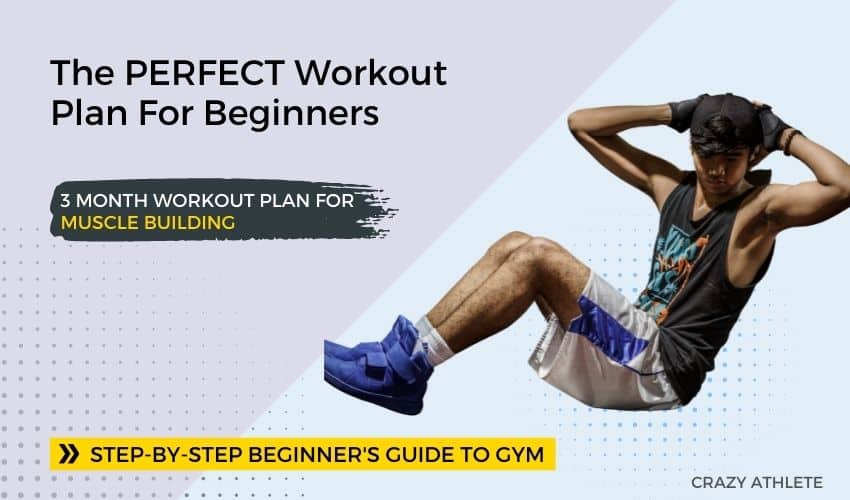
We’ll start this plan with some fundamental exercise movements, which will assist us in learning the proper form of the exercises.
By doing the basic movements initially, we build a solid base and make our bodies ready to lift heavy workouts in the long run.
And this is the strategy every beginner trainee should follow to build a proper muscle-mind connection, prevent muscle imbalance and avoid future injuries.
We split up three workouts in this beginner workout plan to hit the total body.
- Fullbody workout (A)
- Fullbody workout (B)
- Core and cardio workout (C)
And this workout pattern will follow for the second and third months.
Here, we’ll ensure progressive overload means we’ll give our muscles the proper stimulus they need to grow bigger and stronger.
Note: In this entire 12-week workout plan, we’ll do cardio only once per week, and you can do it on Tuesday or Saturday.
Now, let’s check out how your 3-month beginner workout plan is structured.
Month 1 Beginner Workout Schedule
Our primary focus is to learn the basic exercise’s form in month one and see how our body moves while exercising.
The first month of training is divided into three workouts:
- A – Total body
- B – Total body
- C – Core, carry and cardio
The A and B are the total body workout and are performed in an alternating fashion on Monday, Wednesday and Friday.
So, our week one workout schedule is A, B and A and in week two B, A and B and repeat that fashion for the entire month.
The Workout C will fall in the days in between, on Tuesdays and Saturdays throughout the month.
This means we’ll work out five times per week along with two days off — Thursdays and Sundays.
Note: We’ll follow the SAME workout pattern for the second and third months, respectively.
Here’s your first-month workout schedule:
| Monday | Tuesday | Wednesday | Thursday | Friday | Saturday | Sunday | |
| WEEK 1 | Workout A | Workout C | Workout B | Off Day | Workout A | Workout C | Off Day |
| WEEK 2 | Workout B | Workout C | Workout A | Off Day | Workout B | Workout C | Off Day |
| WEEK 3 | Workout A | Workout C | Workout B | Off Day | Workout A | Workout C | Off Day |
| WEEK 4 | Workout B | Workout C | Workout A | Off Day | Workout B | Workout C | Off Day |
Workout A
- DB Drop Squat – 3 x 12-15 FF
- Single Arm DB Press – 3 x 12-15 FF (each arm)
- Seated Cable Row – 3 x 12-15 FF
- Bodyweight Split Squats – 3 x FF (each leg)
Workout B
- Pushups – 3 x FF
- Reverse Lunge – 3 x 12-15 (each leg)
- Glute Bridge – 3 x FF
- Lat/Banded Pulldown – 3 x 12-15 FF
Workout C
- Standing March – 3 x FF
- Rollups – 3 x FF
- DB Suitcase Carry – 3 x FF (each arm)
- Cardio – 10-15 minutes medium to high intencity
Month 2 Beginner Workout Schedule
Similar to month one, in month two, we divided into three workouts, two full-body workouts and one core and cardio exercise.
- D – Total body
- E – Total body
- F – Core, carry and cardio
In month two, we’ll slightly increase our workout complexity and weight to put more load on our body than the first month.
Here’s your second-month workout schedule:
| Monday | Tuesday | Wednesday | Thursday | Friday | Saturday | Sunday | |
| WEEK 1 | Workout D | Workout F | Workout E | Off Day | Workout D | Workout F | Off Day |
| WEEK 2 | Workout E | Workout F | Workout D | Off Day | Workout E | Workout F | Off Day |
| WEEK 3 | Workout D | Workout F | Workout E | Off Day | Workout D | Workout F | Off Day |
| WEEK 4 | Workout E | Workout F | Workout D | Off Day | Workout E | Workout F | Off Day |
Workout D
- DB Front Squat – 3-4 x 8-12
- DB Overhead Press – 3-4 x 8-12
- DB Tripod Row – 3 x 8-12
- Hip Thrust – 3 x 8-12
- DB Biceps Curl – 3 x 8-12
Workout E
- BB RDL – 3-4 x 8-12
- Suitcase Rev. Lunge – 3 x 12 (each leg)
- DB Bench Press 3-4 x 8-12
- Lat Pulldown 3-4 x 8-12
- Triceps Kickback – 3 x 8-12
Workout F
- Jackknife Sit-up – 3-4 x FF
- Plank – 30-60 seconds
- DB Farmer’s Walk – 3-4 x FF
- Cardio – 15-20 minutes high
Month 3 Beginner Workout Schedule
After two months of training, our body is now ready to hit main and heavier movements, and we’ll do so by increasing our exercise variation and weight.
And again similar to the first two months, we split the third-month training into three workouts:
- G – Total body
- H – Total body
- I – Core, carry, and cardio
Note: Add 5lbs to every set if you are able to perform all sets for stated reps.
Here’s how your third-month workout schedule looks like:
| Monday | Tuesday | Wednesday | Thursday | Friday | Saturday | Sunday | |
| WEEK 1 | Workout G | Workout I | Workout H | Off Day | Workout G | Workout I | Off Day |
| WEEK 2 | Workout H | Workout I | Workout G | Off Day | Workout H | Workout I | Off Day |
| WEEK 3 | Workout G | Workout I | Workout H | Off Day | Workout G | Workout I | Off Day |
| WEEK 4 | Workout H | Workout I | Workout G | Off Day | Workout H | Workout I | Off Day |
Workout G
- BB Squat – 3 x 6-8
- BB Hip Thrust – 3 x 8-10
- BB Overhand Row – 3 x 6-8
- BB Overhead Press – 3 x 6-8
- BB Biceps Curl – 3 x 8-10
Workout H
- Deadlift – 3 x 6-8
- DB Reverse Lunge – 3 x 6-8
- Bench Press – 3 x 6-8
- Pullups – 3 x FF
- Lying Triceps Extension – 3 x 8-12
Workout I
- Bicycle Crunch – 3 x FF
- Hanging Knee Raises – 3 x FF
- DB Overhead Carries – 3 x FF
- Cardio – 20 minutes high
3-Month Beginner Workout Plan: Exercises Explained
Here’s your guide to perform the selected exercises. If any equipment isn’t available to your gym, substitute with one that targets the same muscle groups.
1st Month Exercises Guide: A, B, C
Let’s learn how you’ll perform your first month of A, B, and C exercises.
Dumbbell Drop Squat
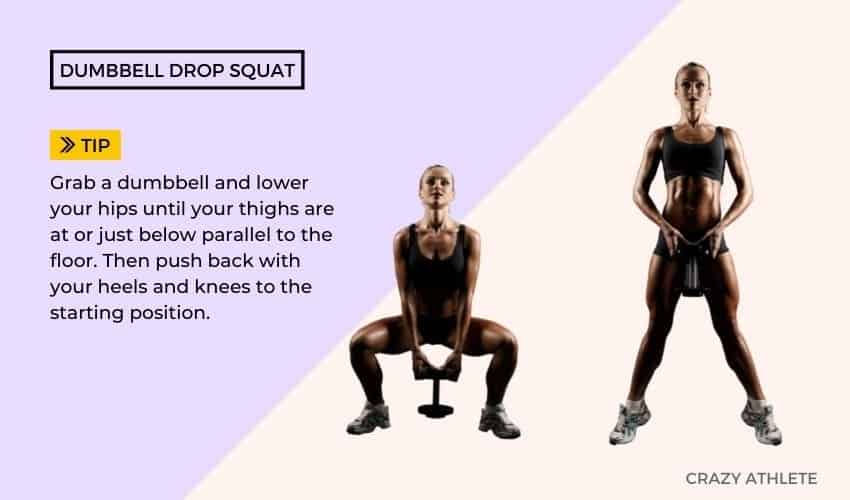
Targets: Legs
How to do it:
- Stand upright with your feet shoulder-width apart.
- Hold a heavy dumbbell infront of your central area.
- Keeping your head up, back straight, chest up, and shoulders locked, squat down by bending your hips back while allowing your knees to slightly come forward.
- Low down until your thighs are at or just below parallel to the floor.
- Push back with your heels to the starting position. Repeat recommended reps.
Single Arm Dumbbell Press
Targets: Shoulders, triceps
How to do it:
- Stand with your feet shoulder-width apart and maintain a straight upright posture.
- Hold a dumbbell with your one hand closer to the shoulder, and the other hand rested on your hips.
- Keeping your core tight and hip engaged, extend the dumbbell straight up toward the ceiling.
- Then back down the dumbbell to the starting position. Perform desired reps, then do with other hand.
Seated Cable Row
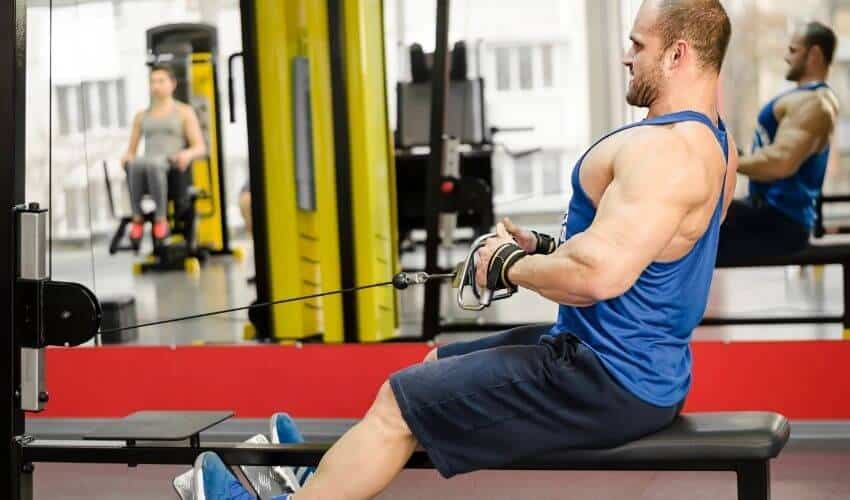
Targets: Back
How to do it:
- Sit on a bench/box with your feet flat on the floor and spine neutral.
- Wrap a resistance band on equipment or use a pull-up machine and set it at your chest height position.
- Hold each end of the resistance band just in front of your knees.
- Pull both sides of the resistance band together towards your ribs while the elbows are facing back.
- Contract back muscles and then release back to the starting position. Repeat.
Bodyweight Split Squat

Targets: Legs
How to do it:
- Place your hands at your hips and take a step forward with your left leg.
- Stand in that position. Slowly bend your knees and lower yourself until both knees make a 90-degree angle.
- Staying that position, up yourself. Repeat desired repetitions and then switch to another leg.
Pushups
Targets: Chest, triceps
How to do it:
- Start with the pushup position. Keep your body straight (head to heel), legs together, and hands placed on the floor slightly wider than shoulder-width.
- Bent your elbow and lower your chest towards the floor.
- Push back with your arms to the starting position. Repeat.
Reverse Lunge
Targets: Legs
How to do it:
- Stand with your feet together and hands at your sides or placed at your mid-area.
- Keeping your core tight and chest up, step back your right leg and lunge. Stop when your left thigh parallels to the ground. Make sure you are putting the loads on your front leg.
- Push back with your right leg to the starting position, then stepping back your left leg and repeat the same. Perform the recommended reps.
Glute Bridge
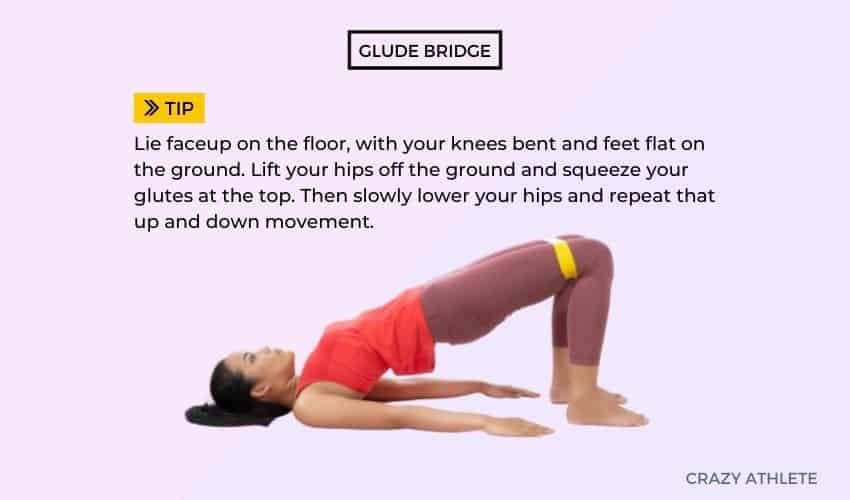
Targets: Glutes, hamstring
How to do it:
- Lie on your back with your knees bent, feet flat on the ground, and extend your arms on the floor.
- Keeping your core tight, push with your heels and up the central area until your hips are fully extended, squeeze your glutes at the top and hold for 3-5 seconds.
- Then slowly lower your hips. Repeat.
Lat/Banded Pulldown
Targets: Back, biceps
How to do it:
- Sit on a bench with feet flat on the ground and spine neutral.
- Lock the door anchor at the door or any equipment at above head position, hold each end of the band or pulldown bar and sit on the bench.
- Pull both sides of the resistance band together toward your ribs, with elbows facing down and contract back muscles at the bottom.
- Stretch your hands back to the starting position. Repeat.
Standing March
Targets: Core (abs)
How to do it:
- Stand with your feet shoulder-width apart, arms relaxed at your sides.
- Squeezing abs, lift your one knee while keeping the bottom of your foot parallel to the floor.
- Lower your knee back down and repeat with the other leg.
Rollups
Targets: Core
How to do it:
- Lie down on your back on the floor, keep your legs together and hands at your sides.
- Then lift your arms toward the ceiling, curl your chin towards your chest and roll up off the floor.
- Squeeze your abs at the top, then slowly back down with control. Repeat.
Dumbbell Suitcase Carry
Targets: Overall body frame
How to do it:
- Stand with your feet shoulder-width apart, place a heavy dumbbell at your side and pick it up from there.
- After picking the dumbbell up, squeeze your shoulder blades together, make your chest up and hips tight, and your other hand at your side.
- Start walking as much as you can, then switch the dumbbell to the other hand and repeat.
Cardio
In month one of the beginner workout plan, we’ll perform about 10-15 minutes of moderate to high-intensity cardio.
And that could be treadmill running, resistance cycling, or high-intensity cardio movements, and you can perform it anywhere.
Related: 13 Best Cardio Exercises You Can Do at Home
2nd Month Exercises Guide: D, E, F
Let’s learn how to perform the month two exercises of this 3-month beginner workout plan.
Dumbbell Front Squat
Targets: Legs
How to do it:
- Stand with your feet slightly wider than hip-width apart.
- Hold a pair of dumbbells up to your shoulders so that one end of each dumbbell rests on your shoulder and elbows facing forward.
- Keeping your head facing forward, back straight, and chest up; squat down by bending your hips back and knees come forward slightly.
- Low down until your thighs are at or just below parallel to the floor.
- Push back with your heels to the starting position. Repeat desired reps.
Dumbbell Overhead Press
Targets: Shoulders, triceps
How to do it:
- Stand with your feet shoulder-width apart, and hold two dumbbells rested on your shoulders and elbows facing forward.
- Keeping your core tight, chest up and hips squeezed, push the dumbbells all the way up towards the ceiling.
- Then slowly lower the dumbbells to the starting position. Repeat.
Dumbbell Tripod Row
Targets: Upper back
How to do it:
- Stand infront of a bench or knee height platform.
- Hinge forward, place one hand on the bench, shoulders slightly higher than the hips, head neutral position, and neck relaxed.
- Grab a dumbbell with one hand on a neutral grip.
- Keeping your core tight and shoulder blades squeezed, pull your elbow behind your body while retracting the shoulder blade.
- Squeeze your back at the top, then stretch your hand down to the starting position. Repeat.
Hip Thrust
Targets: Hips
How to do it:
- Place a bench behind your back. Sit down on the floor and put your upper back on the bench and feet flat on the ground.
- Keeping your core tight and back straight, lift your glutes through heels, squeeze your glutes at the top and hold there for three seconds.
- Make sure you created a straight line from your knees to your shoulders at the top.
- Then slowly lower your glutes back to the starting position. Repeat.
Dumbbell Biceps Curl
Targets: Biceps
How to do it:
- Sand with an upright posture, hold a pair of dumbbells at your sides on a neutral grip.
- Keeping your whole body straight and tight, lift both dumbbells together up towards your shoulders and squeeze at the biceps.
- Be sure all tension should be on the biceps.
- Then slowly back down by controlling the negative movement. Repeat.
Barbell RDL
Targets: Legs
How to do it:
- Stand with your feet shoulder-width apart, and hold a bar with your hands, touching on your thighs.
- Keep your back straight, core tight, chest up, and slightly bent knees.
- Slowly start leaning forward while hips back, and the bar travels down slightly below your knees while building the tension around your hamstring (upper backside of your legs).
- Then up the bar to the starting position. Repeat.
Suitcase Reverse Lunge
Targets: Legs
How to do it:
- Stand with your feet together and grab a dumbbell with your right hand and other hand at your side.
- Keep your core tight and chest up, step back your right leg, and lunge until your left thigh parallels the ground.
- Be sure all the loads are on the front leg.
- Push back up with your right leg to the starting position. Repeat desired reps.
- Then switch your dumbbell to your other hand and repeat the same.
DB Bench Press
Targets: Chest
How to do it:
- Start with put the dumbbells in front of the bench and pick them up to your knees.
- Next, sit back on the bench and lie down while bringing the dumbbells above your chest while keeping your wrist straight.
- Make sure your feet are firmly placed on the floor.
- Then bend your elbow and lower your arm to a 90-degree angle above your nipples.
- Next, push the dumbbells straight up while engaging your chest.
- Repeat that up and down movement as recommended reps.
Lat Pulldown
Targets: Back
How to do it:
- First, adjust the pullup bar to a slightly lightweight, grab the handle shoulder-width apart or where you’re comfortable.
- Hold the bar, sit down on the bench/platform and place your feet flat on the ground.
- Keeping your chest up, pull down the elbow back and squeeze the back at the bottom.
- Then stretch your arms as high as you can go. Repeat that up and down movement as recommended reps.
Triceps Kickback
Targets: Triceps
How to do it:
- Grab a lighter dumbbell and go over to put one leg up on the bench and the opposite leg on the floor.
- Lean forward and maintain a little bit of arched back.
- Maintain your spine and neck in a neutral position.
- Keeping your shoulders locked and slightly up your elbow to make your arms parallel to the ground, kick the dumbbell back while contracting your triceps.
- Perform that movement as desired. Then switch to the other arm.
Jackknife Sit-up
Targets: Core
How to do it:
- Lie down on the floor on your back and extend your arms straight behind your head.
- Exhale and bend at the waist while simultaneously raising your legs and arms to meet in a jackknife position.
- Your legs should be lifted at about a 45-degree angle from the floor, and your arms should be extended in parallel to your legs.
- Your upper torso should be off the floor while contracting core at the top.
- Then lower your arms and legs to the starting position. Repeat.
Plank
Targets: Core
How to do it:
- Start with a pushup position. Place your elbows and toes on the floor, and keep your body straight.
- Create muscle mind connection and squeeze your abdominal muscle.
- Tight your abs and hold them for 30 seconds or as long as you can.
Dumbbell Farmer’s Walk

Targets: Overall Frame
How to do it:
Place a pair of heavy dumbbells at your sides and pick them up from there.
Squeezing your shoulder blades together, chest up and hip engaged, start walking.
Make sure your cadence and step length are steady and consistent while staying straight ahead in the right line without having drifting going on.
Cardio
In month two, we’ll do 15-20 minutes of moderate to high-intensity cardio workout.
You can do treadmill running or any aerobic activity that raises your heart rate above about 110 beats per minute to go in the cardiovascular zone.
Related: How Many Times Per Week Should You Do Cardio?
3rd Month Exercises Guide: G, H, I
Okay, after two months of doing basic and lighter movements, we’ll now increase the complexity of exercises and weight to make our training more intensive and challenging.
Note: Add 5 pounds to each workout on each lift if you’re able to achieve all recommended sets and reps successfully. If not, go back with the previous weight and master that first, then try heavier.
Remember, you should pick a weight that you know you can perform the recommended reps for, but it will still challenge you.
Barbell Squat
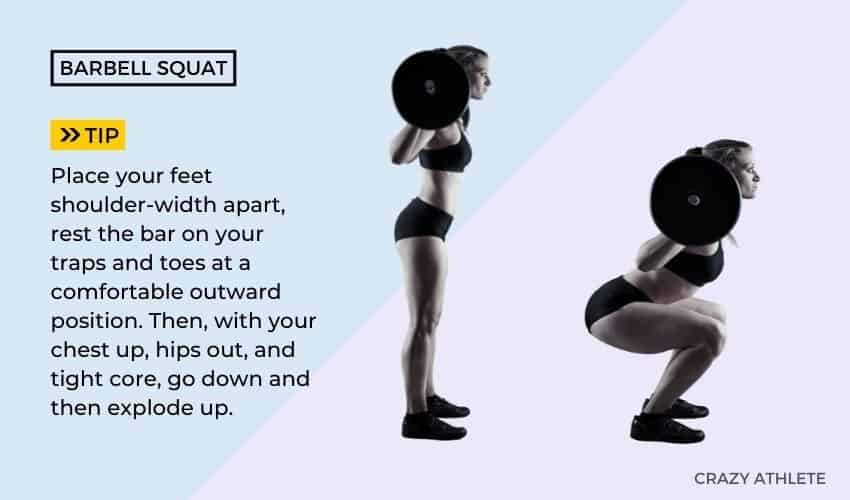
Targets: Legs
How to do it:
Stand with your feet shoulder-width apart and place both your hands a little wider than shoulder-width apart on the bar.
Then rest the bar on your traps (upper part of your back) and keep your toes at a comfortable outward position. Be sure don’t rest the bar on your neck.
With your chest up, hips out, and straight back, start lowering your body at 90 degrees or your thighs parallel to the ground.
Then putting pressure through your heels, lead with your chest while pushing your hips forward, raise yourself. Repeat that up and down movement as desired.
Barbell Hip Thrust

Targets: Hips
How to do it:
- Place a bench behind your back and sit down on the floor.
- Put a barbell on the midsection of your body and hold it there with your hands.
- Then, bend your knees, back rested on the bench, tight your core, and feet flat on the floor.
- Then drive through your heels, squeezed up your glutes, and hold for three seconds. Be sure you make a straight line from your knees to your shoulders.
- Come back down and repeat the up and down movement as recommended reps.
Barbell Overhead Press
Targets: Shoulders
How to do it:
- Begin with standing in front of the barbell rack. Grab the bar with your hands slightly wider than shoulder-width apart.
- Then, unrack the bar and bring it under your chin or closer to your upper chest.
- Keep your elbow facing in the front, push the bar straight all the way up to the top, and then lower the bar under your chin. Repeat.
Barbell Overhand Row

Targets: Back
How to do it:
Stand infront of a barbell. Keep your back flat and knees slightly bent, hinge at your hips to grab the bar with an overhand (your palm facing inward) grab about a little wider than shoulder-width apart.
Pull your shoulder back and down while keeping your back flat at about a 60-degree angle.
And while keeping your hips high and chest up, pull the barbell in towards your stomach and aim for your belly button.
Squeeze your shoulder blades at the top, then extend your arms back to your starting position. Repeat.
Barbell Curl
Targets: Biceps
How to do it:
- Stand with your feet shoulder-width apart, maintain an upright posture, and grab a straight/easy bar shoulder-width apart.
- Keep your body nice and straight, shoulder blades squeezed, and elbows are locked in place.
- Next, curl the bar up towards your shoulders and squeeze your biceps.
- Then slowly come back down to the starting position. Repeat.
Deadlift

Targets: Hamstring, back
How to do it:
- Start by standing in front of a heavy barbell with your feet shoulder-width apart.
- Make your butt out, chest up, bend your knees, go down and make an overhand grip to the barbell at a slightly wider than shoulder-width.
- Squeeze your shoulder blades together, look up at the front, maintain a tight core.
- Then pull the barbell up by focusing on your hamstring (make sure you’re not using your lower back).
- Squeeze your glutes and keep a straight position at the top. Remember, don’t bend too far back.
- Lower the bar down while keeping your head up, chest forward, and butt out. And tap the barbell on the floor, then come back up. Repeat your desired reps.
Dumbbell/Barbell Reverse Lunge
Targets: Legs
How to do it:
- Stand with your feet together and grab a pair of dumbbells with your hands at your sides.
- Keep your core tight and chest up, step back your right leg, and lunge until your left thigh parallels the ground.
- Be sure all the loads are on the front leg.
- Push back with your right leg to the starting position.
- Then do the same with other leg. Repeat desired repetitions.
Bench Press
Targets: Chest, triceps, shoulders
How to do it:
- Start with lie on the bench under a barbell rack. Grab the bar with a slightly outside shoulder grip.
- Keeping your hips placed on the bench with a slight arch on your lower back and your feet flat on the ground, unrack the bar and bring it over your nipple line.
- Keep your shoulder blades squeeze together as you lower the bar to your nipple line, then press the bar up to the starting position while contracting your chest. Repeat.
- Make sure your elbow and upper arms are at a 45-degree angle to your torso. And try to move the bar as a straight line up and down as possible.
Pullups
Targets: Back, biceps, shoulders
How to do it:
- Stand under a pullup bar. Begin with making an overhand grip on the bar slightly wider than shoulder-width.
- With arms extended above you, stick your chest out and curve your back slightly.
- Then pull yourself up towards the bar using your back until the bar is at chest level while breathing out.
- Repeat that up and down movement as many as you can.
Lying Triceps Extention
Targets: Triceps
How to do it:
- Take a slightly light straight/easy bar, lie down on the bench, and feet flat on the ground.
- Grab the barbell slightly closer shoulder-width apart and take it over your chest.
- Keeping your arms perpendicular to the body, lower the barbell to your forehead or over your head (for more tension) and extend back up using triceps.
- Repeat that movement as desired.
Bicycle Crunch
Targets: Core
How to do it:
- Lie down flat on the ground on your back.
- Keeping your core tight, lift one left leg and extend it out, and lift the right leg and bend your knee towards your chest.
- Then move your left elbow towards your right knee and squeeze your core while your knee and elbow are moving closer.
- You don’t need to touch your elbow to knee. And do the same with the opposite leg and hand.
- Repeat your desired number of reps.
Hanging Knee Raises
Targets: Core
How to do it:
- Stand under a bar, grip the bar on a slightly wider than shoulder-width position, and hang yourself.
- Then exhale and up your knees until your thighs parallel to the ground.
- Squeeze your abs at the top, then extend your knees back down. Repeat.
Dumbbell Overhead Carries
Targets: Overall frame
How to do it:
- Stand with your feet shoulder-width apart, grab a pair of dumbbells.
- Keep your back straight, chest up, and hips squeezed.
- Then push the dumbbells straight up and hold them there.
- With this position, start walking as much as you can.
- Make sure your step lengths are steady and consistent while staying straight ahead in the right line without having drifting going on.
Cardio
We’ll perform about 20 minutes of moderate-high intensity cardio exercise in the third month of this beginner workout plan.
Again that could be in the form of cycling, running, swimming, dancing, etc. Our primary focus should be getting our heart rate above 110 beats per minute.
Beginner Workout Plan FAQs
Can I train each body part on a separate day?
Shortly, NO. Because training each body part on a separate day (split routine) is a too advanced workout program and not advisable to beginners.
And also, following a split workout, in the beginning can provide you too much fatigue to your body which will increase your recovery time and slow down your progress.
So, begin with a full-body workout plan (like that already discussed) is ideal where you’ll learn the exercises’ basics and build a solid foundation which is crucial for beginners.
Starting your fitness journey with the right training program is critical because you get the advantage of “newbie gains,” where your body has the optimal ability to grow in the first year or two.
How many days a week do I need to go to the gym?
Although there is no fixed rule, you have to train that much time to achieve your specific goal. But there’re numbers studies suggest that you can follow to improve your overall health.
According to WHO guidelines, an adult (18-64 years) should do at least 150–300 minutes of moderate to high intensity aerobic physical activity per week to maintain a healthy life.
And that should be a combination of 2 or more days of muscle-strengthening activity to get the additional health benefits.
So, as a beginner, training around 30-60 minutes of 3-5 days a week is perfectly fine (and this suits most of the workout programs) to crush any specific fitness goal.
If you want to know more about how many times working out is best for gaining muscle, losing fat, or improving overall health, I recommend reading this article to find out the best workout frequency to achieve your desired goals.
After this program, what to do next?
It’s really up to you.
If you want to continue to build that strength, you can certainly stick to that third-month workout plan for the next one-two months and continue to add weight and do that.
Then, if you want to shift your goal and focus on building muscle, I’ve got a three-month plan that includes a complete workout and nutritional plan to gain lean muscles.
Or, if you want to learn the step-by-step muscle building formula and want to build lean muscle mass, I would highly recommend you to head over this article, and you’ll be good to go.
Conclusion
Okay, now you’ve got a step-by-step science-based game plan to kickstart your fitness journey, and make sure you follow this plan step-by-step.
Now, I want to know what your fitness goal is?
Is it building muscle, losing fat, or both?
And, don’t forget to give your feedback about this beginner workout plan in the comment section below. I would love to hear from you!
Best of luck!
Read next: 13 Things to Do After a Workout (and 8 to Avoid!)
